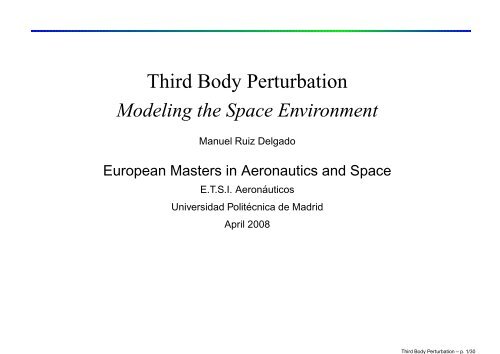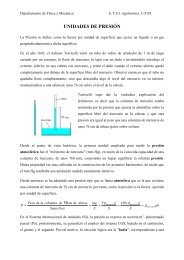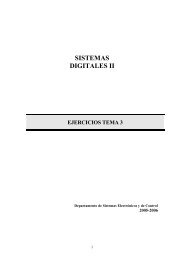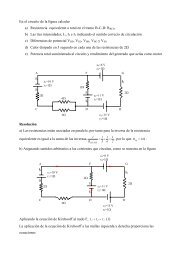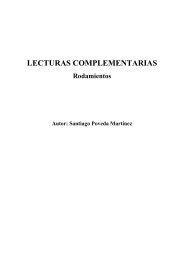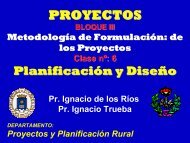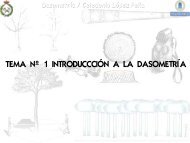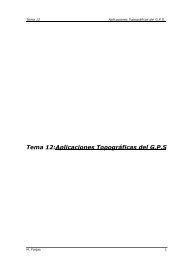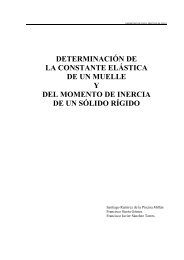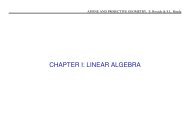Third Body Perturbation - OCW UPM
Third Body Perturbation - OCW UPM
Third Body Perturbation - OCW UPM
You also want an ePaper? Increase the reach of your titles
YUMPU automatically turns print PDFs into web optimized ePapers that Google loves.
<strong>Third</strong> <strong>Body</strong> <strong>Perturbation</strong><br />
Modeling the Space Environment<br />
Manuel Ruiz Delgado<br />
European Masters in Aeronautics and Space<br />
E.T.S.I. Aeronáuticos<br />
Universidad Politécnica de Madrid<br />
April 2008<br />
<strong>Third</strong> <strong>Body</strong> <strong>Perturbation</strong> – p. 1/30
Modeling the Space Environment<br />
Particle Dynamics: Basics of Orbital Mechanics:<br />
Two-<strong>Body</strong> problem: Keplerian Motion KEPLER.FOR<br />
Equations for Perturbed Motion COWELL.FOR<br />
<strong>Perturbation</strong>s: Models<br />
Gravitational<br />
Real Earth Gravitational Field: JGM2S<br />
<strong>Third</strong> body perturbation: ECSS/DE200<br />
Non-Gravitational<br />
Air Drag: Static and Dynamic Models: MSISE00<br />
Radiation Pressure ECSS-E-10-04A/DE200<br />
Magnetic Field: IGRF<br />
Ionospheric Effects: IRI<br />
Debris and Meteoroid Impact: MASTER/ORDEM<br />
Attitude Dynamics: Gravitational and Non-Gravitational torques<br />
<strong>Third</strong> <strong>Body</strong> <strong>Perturbation</strong> – p. 2/30
3rd <strong>Body</strong> <strong>Perturbation</strong>: Index<br />
Inertial formulation for N bodies<br />
Primary formulation for N bodies<br />
Application to Earth orbits<br />
Potential: avoiding 1-1 loss of precision<br />
Acceleration: avoiding 1-1 loss of precision<br />
Gradient of Potential<br />
Truncated expansion of vector difference<br />
Exact Scalar function for vector difference<br />
Position vectors of Sun and Moon<br />
Position vectors through Almanach formulas: Vallado’s routines<br />
SUN(), MOON()<br />
Position vectors through Ephemerides: JPL routines<br />
Visualization of 3rd body effects<br />
VOP results on 3rd body effects<br />
<strong>Third</strong> <strong>Body</strong> <strong>Perturbation</strong> – p. 3/30
Inertial Formulation for N Bodies<br />
Isolated system of N particles<br />
Forces: only gravitational interaction (action-reaction)<br />
Inertial Oxyz reference system<br />
Ri position vector of particle i in Oxyz axes
Inertial Formulation for N Bodies<br />
Isolated system of N particles<br />
Forces: only gravitational interaction (action-reaction)<br />
Inertial Oxyz reference system<br />
Ri position vector of particle i in Oxyz axes<br />
¨Ri =<br />
N−1 <br />
i=0<br />
j=i<br />
−Gmj<br />
|Ri − Rj| 3 (Ri − Rj) i,j = 0,...,N − 1
Inertial Formulation for N Bodies<br />
Isolated system of N particles<br />
Forces: only gravitational interaction (action-reaction)<br />
Inertial Oxyz reference system<br />
Ri position vector of particle i in Oxyz axes<br />
¨Ri =<br />
N−1 <br />
i=0<br />
j=i<br />
−Gmj<br />
|Ri − Rj| 3 (Ri − Rj) i,j = 0,...,N − 1<br />
3N coupled ODE’s, 3N unknowns → Numerical integration<br />
Conservation of linear momentum for the whole system: System<br />
COM moves with constant speed ˙ RG<br />
<strong>Third</strong> <strong>Body</strong> <strong>Perturbation</strong> – p. 4/30
Primary formulation for N bodies<br />
Take particle i = 0 as origin<br />
Non-inertial, non-rotating M0xyz reference system
Primary formulation for N bodies<br />
Take particle i = 0 as origin<br />
Non-inertial, non-rotating M0xyz reference system<br />
Ri = R0 + ri
Primary formulation for N bodies<br />
Take particle i = 0 as origin<br />
Non-inertial, non-rotating M0xyz reference system<br />
Ri = R0 + ri<br />
Conservation of linear momentum for the system:<br />
N−1 N−1 <br />
mi¨ri + mi<br />
¨R0 = 0 = M ¨ RG ⇒ ˙ RG,RG<br />
i=1<br />
i=0
Primary formulation for N bodies<br />
Take particle i = 0 as origin<br />
Non-inertial, non-rotating M0xyz reference system<br />
Ri = R0 + ri<br />
Conservation of linear momentum for the system:<br />
N−1 N−1 <br />
mi¨ri + mi<br />
¨R0 = 0 = M ¨ RG ⇒ ˙ RG,RG<br />
i=1<br />
i=0<br />
Introducing relative ri vectors in the inertial formulation:<br />
¨Ri = ¨ R0 + ¨ri =<br />
N−1 <br />
j=0<br />
j=i<br />
−Gmj<br />
|ri − rj| 3 (ri − rj) →
Primary formulation for N bodies<br />
Take particle i = 0 as origin<br />
Non-inertial, non-rotating M0xyz reference system<br />
Ri = R0 + ri<br />
Conservation of linear momentum for the system:<br />
N−1 N−1 <br />
mi¨ri + mi<br />
¨R0 = 0 = M ¨ RG ⇒ ˙ RG,RG<br />
i=1<br />
i=0<br />
Introducing relative ri vectors in the inertial formulation:<br />
¨Ri = ¨ R0 + ¨ri =<br />
N−1 <br />
j=0<br />
j=i<br />
−Gmj<br />
|ri − rj| 3 (ri − rj) →<br />
→ ¨ri =<br />
N−1 <br />
j=0<br />
j=i<br />
−Gmj<br />
|ri − rj| 3 (ri − rj) − ¨ R0<br />
<strong>Third</strong> <strong>Body</strong> <strong>Perturbation</strong> – p. 5/30
Primary Formulation for N bodies<br />
¨R0 from inertial formulation for i = 0:<br />
¨R0 =<br />
N−1 <br />
j=1<br />
−Gmj<br />
|R0 − Rj| 3 (R0 − Rj) =<br />
=<br />
N−1 <br />
j=1<br />
−Gmj<br />
|rj| 3 (−rj)
Primary Formulation for N bodies<br />
¨R0 from inertial formulation for i = 0:<br />
¨R0 =<br />
N−1 <br />
j=1<br />
−Gmj<br />
|R0 − Rj| 3 (R0 − Rj) =<br />
=<br />
N−1 <br />
j=1<br />
−Gmj<br />
|rj| 3 (−rj)<br />
j<br />
O<br />
i<br />
M0
Primary Formulation for N bodies<br />
¨R0 from inertial formulation for i = 0:<br />
¨R0 =<br />
N−1 <br />
j=1<br />
Leading to:<br />
−Gmj<br />
|R0 − Rj| 3 (R0 − Rj) =<br />
¨ri = − GM0ri<br />
+<br />
|ri| 3<br />
=<br />
N−1 <br />
j=1<br />
N−1 <br />
j=1<br />
j=i<br />
−Gmj<br />
|rj| 3 (−rj)<br />
−Gmj (ri − rj)<br />
|ri − rj| 3<br />
−<br />
j<br />
O<br />
N−1 <br />
j=1<br />
i=j<br />
i<br />
M0<br />
Gmjrj Gmiri<br />
− 3<br />
|rj| |ri| 3<br />
<strong>Third</strong> <strong>Body</strong> <strong>Perturbation</strong> – p. 6/30
¨ri =<br />
j<br />
O<br />
Primary Formulation for N bodies<br />
primary inertia direct indirect<br />
<br />
− G (M0<br />
<br />
+ mi)ri<br />
N−1 <br />
<br />
<br />
rj − ri<br />
+ Gmj<br />
−<br />
|rj − ri| 3<br />
|ri| 3<br />
<br />
i<br />
M0<br />
j=1<br />
j=i<br />
j<br />
rj<br />
|rj| 3<br />
<br />
Kepler 2 body <strong>Perturbation</strong><br />
Pdir<br />
2B<br />
i<br />
M0<br />
Pind<br />
Kepler<br />
<strong>Third</strong> <strong>Body</strong> <strong>Perturbation</strong> – p. 7/30
Application to Earth Orbits<br />
Primary: Earth, M0 = M⊕<br />
Satellite mass always neglected in augmented mass:<br />
M⊕ = 5.973 · 10 24 kg, m < 10 4 kg
Application to Earth Orbits<br />
Primary: Earth, M0 = M⊕<br />
Satellite mass always neglected in augmented mass:<br />
M⊕ = 5.973 · 10 24 kg, m < 10 4 kg<br />
<strong>Perturbation</strong>s: Moon > Sun ⊙≫ Venus ♀ ≃ Jupiter <br />
M <br />
M⊙<br />
≃ 10−3<br />
a <br />
a⊕<br />
= 5.2 AU
Application to Earth Orbits<br />
Primary: Earth, M0 = M⊕<br />
Satellite mass always neglected in augmented mass:<br />
M⊕ = 5.973 · 10 24 kg, m < 10 4 kg<br />
<strong>Perturbation</strong>s: Moon > Sun ⊙≫ Venus ♀ ≃ Jupiter <br />
M <br />
M⊙<br />
≃ 10−3<br />
Direct: over the satellite<br />
Indirect: over the Earth (-)<br />
a <br />
a⊕<br />
= 5.2 AU<br />
Numerical problems for Earth/satellite system:<br />
Direct Pert ≃ Indirect Pert → Loss of precision
Application to Earth Orbits<br />
Primary: Earth, M0 = M⊕<br />
Satellite mass always neglected in augmented mass:<br />
M⊕ = 5.973 · 10 24 kg, m < 10 4 kg<br />
<strong>Perturbation</strong>s: Moon > Sun ⊙≫ Venus ♀ ≃ Jupiter <br />
M <br />
M⊙<br />
≃ 10−3<br />
Direct: over the satellite<br />
Indirect: over the Earth (-)<br />
a <br />
a⊕<br />
= 5.2 AU<br />
Numerical problems for Earth/satellite system:<br />
Direct Pert ≃ Indirect Pert → Loss of precision<br />
2 Approaches:<br />
Potential: VOP-Lagrange, Analytical approximations Battin<br />
Acceleration: Numerical Vallado, Montenbruck<br />
<strong>Third</strong> <strong>Body</strong> <strong>Perturbation</strong> – p. 8/30
Acceleration (m/s 2 )<br />
1e+006<br />
10000<br />
100<br />
1<br />
0.01<br />
0.0001<br />
1e−006<br />
1e−008<br />
Magnitude of <strong>Perturbation</strong>s (LEO)<br />
Accelerations of the Satellite (BC=50)<br />
Shuttle<br />
ISS<br />
0 100 200 300 400 500 600 700 800 900<br />
Height (km)<br />
Kepler<br />
J2<br />
C 22<br />
Sun<br />
Moon<br />
Drag (low)<br />
Drag (high)<br />
P rad<br />
<strong>Third</strong> <strong>Body</strong> <strong>Perturbation</strong> – p. 9/30
Acceleration (m/s 2 )<br />
1e+006<br />
10000<br />
100<br />
1<br />
0.01<br />
0.0001<br />
1e−006<br />
1e−008<br />
Magnitude of <strong>Perturbation</strong>s (GEO)<br />
Accelerations of the Satellite (BC=50)<br />
GPS<br />
0 5000 10000 15000 20000 25000 30000 35000 40000<br />
Height (km)<br />
Kepler<br />
J2<br />
C 22<br />
Sun<br />
Moon<br />
Drag (low)<br />
Drag (high)<br />
P rad<br />
GEO<br />
<strong>Third</strong> <strong>Body</strong> <strong>Perturbation</strong> – p. 10/30
Potential: <strong>Perturbation</strong> Function<br />
2-<strong>Body</strong> and <strong>Perturbation</strong> terms derive from potential functions:<br />
G (M0 + mi)<br />
¨ri = ∇i + ∇iRi<br />
ri
Potential: <strong>Perturbation</strong> Function<br />
2-<strong>Body</strong> and <strong>Perturbation</strong> terms derive from potential functions:<br />
The perturbation acceleration<br />
G (M0 + mi)<br />
¨ri = ∇i<br />
N−1 <br />
j=1<br />
j=i<br />
Gmj<br />
<br />
ri<br />
+ ∇iRi<br />
rj − ri rj<br />
−<br />
|rj − ri| 3<br />
|rj| 3
Potential: <strong>Perturbation</strong> Function<br />
2-<strong>Body</strong> and <strong>Perturbation</strong> terms derive from potential functions:<br />
The perturbation acceleration<br />
G (M0 + mi)<br />
¨ri = ∇i<br />
N−1 <br />
j=1<br />
j=i<br />
Gmj<br />
<br />
ri<br />
+ ∇iRi<br />
rj − ri rj<br />
−<br />
|rj − ri| 3<br />
|rj| 3<br />
derives from <strong>Perturbation</strong> Function: ∇i = ∂<br />
∂ri<br />
Ri =<br />
N−1 <br />
i=1<br />
i=j<br />
Gmj<br />
<br />
<br />
1<br />
|ri − rj| −rj · ri<br />
r3 <br />
j<br />
<strong>Third</strong> <strong>Body</strong> <strong>Perturbation</strong> – p. 11/30
j<br />
Potential: Avoiding 1-1 Loss of Precision<br />
rj θij<br />
i<br />
ri<br />
M0<br />
Far body over Earth/satellite system<br />
⇒ rj ≫ ri<br />
θij angle between ri and rj
j<br />
Potential: Avoiding 1-1 Loss of Precision<br />
rj θij<br />
i<br />
ri<br />
M0<br />
Far body over Earth/satellite system<br />
⇒ rj ≫ ri<br />
θij angle between ri and rj<br />
<br />
ri<br />
rj · ri<br />
r 3 j<br />
= 1<br />
rj<br />
rj<br />
cosθij
j<br />
Potential: Avoiding 1-1 Loss of Precision<br />
rj θij<br />
i<br />
ri<br />
M0<br />
Far body over Earth/satellite system<br />
⇒ rj ≫ ri<br />
θij angle between ri and rj<br />
<br />
ri<br />
rj · ri<br />
r 3 j<br />
= 1<br />
rj<br />
rj<br />
cosθij<br />
Expansion in Legendre polynomials of argument cosθij<br />
1 1 1<br />
= <br />
|ri − rj| rj<br />
2 <br />
=<br />
ri ri<br />
1+ −2<br />
1<br />
∞<br />
<br />
ri<br />
rj rj<br />
n=0<br />
rj<br />
rj<br />
cos θij<br />
n<br />
Pn (cosθij)<br />
<strong>Third</strong> <strong>Body</strong> <strong>Perturbation</strong> – p. 12/30
Potential: Avoiding 1-1 Loss of Precision<br />
n = 0 : 1<br />
r j , Does not depend on ri: neglect
Potential: Avoiding 1-1 Loss of Precision<br />
n = 0 : 1<br />
r j , Does not depend on ri: neglect<br />
n = 1 : 1<br />
<br />
ri<br />
cosθij − 1<br />
<br />
ri<br />
cosθij , both cancel<br />
rj<br />
rj<br />
rj<br />
rj
Potential: Avoiding 1-1 Loss of Precision<br />
n = 0 : 1<br />
r j , Does not depend on ri: neglect<br />
n = 1 : 1<br />
<br />
ri<br />
cosθij − 1<br />
<br />
ri<br />
cosθij , both cancel<br />
rj<br />
rj<br />
Only n ≥ 2 terms of the direct perturbation remain<br />
rj<br />
rj
Potential: Avoiding 1-1 Loss of Precision<br />
n = 0 : 1<br />
r j , Does not depend on ri: neglect<br />
n = 1 : 1<br />
<br />
ri<br />
cosθij − 1<br />
<br />
ri<br />
cosθij , both cancel<br />
rj<br />
rj<br />
Only n ≥ 2 terms of the direct perturbation remain<br />
Ri =<br />
N−1 <br />
j=1<br />
j=i<br />
No numerical problems<br />
Use recurrence relations<br />
Gmj<br />
rj<br />
rj<br />
∞<br />
n=2<br />
rj<br />
ri<br />
rj<br />
n<br />
Pn (cosθij)<br />
Fast convergence for ri ≪ rj: take few terms (1 for ⊙, 2 for )<br />
<strong>Third</strong> <strong>Body</strong> <strong>Perturbation</strong> – p. 13/30
Acceleration: Avoiding 1-1 Loss of Precision<br />
Several approaches to compute 3rd <strong>Body</strong> perturbation acceleration<br />
Must avoid 1-1 loss of precision<br />
Gradient of truncated <strong>Perturbation</strong> Function (Maple sheet)<br />
Truncated expansion of vector difference (Vallado,<br />
Montenbruck)<br />
Exact f(q) scalar formula for vector difference (Battin)<br />
Truncated methods converge fast:<br />
Sun:<br />
rsat ≪ 1 only 1 term<br />
Moon:<br />
rsat<br />
r⊙<br />
r⊙<br />
≪ rsat<br />
r ≪ 1 at least 2 terms<br />
<strong>Third</strong> <strong>Body</strong> <strong>Perturbation</strong> – p. 14/30
⊙<br />
r⊙<br />
r⊙<br />
Acceleration: Truncated vector expansion<br />
⊕<br />
<br />
r<br />
<strong>Perturbation</strong> acceleration due to Sun:<br />
a⊙ = +µ⊙<br />
r⊙<br />
r 3 ⊙<br />
r⊙<br />
− µ⊙<br />
r3 ⊙<br />
<strong>Third</strong> <strong>Body</strong> <strong>Perturbation</strong> – p. 15/30
⊙<br />
r⊙<br />
r⊙<br />
Acceleration: Truncated vector expansion<br />
⊕<br />
<br />
r<br />
<strong>Perturbation</strong> acceleration due to Sun:<br />
a⊙ = +µ⊙<br />
r⊙<br />
r 3 ⊙<br />
r⊙<br />
− µ⊙<br />
r3 ⊙<br />
1 1<br />
Taylor expansion of =<br />
r⊙<br />
3 3 :<br />
|r⊙ − r|<br />
<br />
r − 3 r · r⊙<br />
r⊙ 2 <br />
r⊙ + ...<br />
a⊙ = − µ⊙<br />
r⊙ 3<br />
<strong>Third</strong> <strong>Body</strong> <strong>Perturbation</strong> – p. 15/30
⊙<br />
r⊙<br />
r⊙<br />
Acceleration: Truncated vector expansion<br />
⊕<br />
<br />
r<br />
<strong>Perturbation</strong> acceleration due to Sun:<br />
a⊙ = +µ⊙<br />
r⊙<br />
r 3 ⊙<br />
r⊙<br />
− µ⊙<br />
r3 ⊙<br />
1 1<br />
Taylor expansion of =<br />
r⊙<br />
3 3 :<br />
|r⊙ − r|<br />
<br />
r − 3 r · r⊙<br />
r⊙ 2 <br />
r⊙ + ...<br />
a⊙ = − µ⊙<br />
r⊙ 3<br />
One additional term for the Moon:<br />
a = − µ<br />
r 3<br />
<br />
r − 3 r · r<br />
r 2 r − 15<br />
2<br />
r · r<br />
r 2<br />
• Vallado, 3rd Ed, p. 571 ff; Montenbruck, p. 69 ff<br />
2<br />
r + ...<br />
<br />
<strong>Third</strong> <strong>Body</strong> <strong>Perturbation</strong> – p. 15/30
⊙<br />
a⊙ = −µ⊙<br />
r⊙<br />
d<br />
Acceleration: exact scalar function<br />
d r⊙<br />
− µ⊙<br />
d3 r3 ⊙<br />
⊕<br />
<br />
r<br />
<strong>Third</strong> <strong>Body</strong> <strong>Perturbation</strong> – p. 16/30
⊙<br />
a⊙ = −µ⊙<br />
r⊙<br />
d<br />
Acceleration: exact scalar function<br />
d r⊙<br />
− µ⊙<br />
d3 r3 =<br />
⊙<br />
−µ⊙<br />
d3 d<br />
<br />
r − r⊙ + d3<br />
r3 <br />
r⊙<br />
⊙<br />
⊕<br />
<br />
r<br />
=<br />
<strong>Third</strong> <strong>Body</strong> <strong>Perturbation</strong> – p. 16/30
⊙<br />
a⊙ = −µ⊙<br />
r⊙<br />
d<br />
Acceleration: exact scalar function<br />
d r⊙<br />
− µ⊙<br />
d3 r3 =<br />
⊙<br />
−µ⊙<br />
d3 d<br />
<br />
r − r⊙ + d3<br />
r3 ⊙<br />
⊕<br />
<br />
r<br />
= −µ⊙<br />
d 3<br />
<br />
r⊙<br />
<br />
=<br />
r − r⊙<br />
<br />
1 − d3<br />
r3 <br />
⊙<br />
<br />
−f(q)<br />
<br />
<strong>Third</strong> <strong>Body</strong> <strong>Perturbation</strong> – p. 16/30
⊙<br />
a⊙ = −µ⊙<br />
r⊙<br />
d<br />
Acceleration: exact scalar function<br />
d r⊙<br />
− µ⊙<br />
d3 r3 =<br />
⊙<br />
−µ⊙<br />
d3 d<br />
<br />
r − r⊙ + d3<br />
r3 ⊙<br />
⊕<br />
<br />
r<br />
= −µ⊙<br />
d 3<br />
<br />
r⊙<br />
<br />
=<br />
r − r⊙<br />
q = r · (r − 2r⊙)<br />
r⊙ · r⊙<br />
f(q) = q<br />
3 + 3q + q2<br />
1 + (1 + q) 2<br />
<br />
1 − d3<br />
r3 <br />
⊙<br />
<br />
−f(q)<br />
<br />
<strong>Third</strong> <strong>Body</strong> <strong>Perturbation</strong> – p. 16/30
⊙<br />
a⊙ = −µ⊙<br />
r⊙<br />
d<br />
Acceleration: exact scalar function<br />
d r⊙<br />
− µ⊙<br />
d3 r3 =<br />
⊙<br />
−µ⊙<br />
d3 d<br />
<br />
r − r⊙ + d3<br />
r3 ⊙<br />
⊕<br />
<br />
r<br />
= −µ⊙<br />
d 3<br />
<br />
r⊙<br />
<br />
=<br />
r − r⊙<br />
q = r · (r − 2r⊙)<br />
r⊙ · r⊙<br />
f(q) = q<br />
3 + 3q + q2<br />
1 + (1 + q) 2<br />
• Note the different sense of d<br />
• The same for the Moon vector r, with µ.<br />
• Cf. Battin, Introduction to the Mathematics and Methods of<br />
Astrodynamics, AIAA<br />
<br />
1 − d3<br />
r3 <br />
⊙<br />
<br />
−f(q)<br />
<br />
<strong>Third</strong> <strong>Body</strong> <strong>Perturbation</strong> – p. 16/30
Needed for several reasons:<br />
3rd <strong>Body</strong> perturbation<br />
Position Vectors r⊙ and r<br />
Sun’s radiation pressure perturbation<br />
Shadow function for SRP<br />
Solar panel orientation, attitude through sun sensor, etc.<br />
Depending on required precision:<br />
Low: Probably, no need to compute this perturbation<br />
Middle: Astronomical Almanach formulas for the Sun (⊙) and Moon<br />
() position vectors Vallado routines<br />
High: Interpolate high-precision ephemeris files (JPL DEXXX)<br />
DE200 series: uses J2000<br />
DE400 series: uses ICRF<br />
<strong>Third</strong> <strong>Body</strong> <strong>Perturbation</strong> – p. 17/30
Geometry for Sun Position Vector<br />
λeclipt<br />
<br />
r⊙<br />
φecl α⊙<br />
Almanach routines use Ecliptic longitude λ and latitude<br />
φ. Transfer to rectangular coordinates and<br />
Equatorial right ascension α and declination δ<br />
λeclipt<br />
MEqEqxJ2000<br />
δ⊙<br />
r⊙<br />
Sun right ascension α⊙<br />
Sun declination δ⊙<br />
Obliquity of Ecliptic ǫ ≃ φecl<br />
<strong>Third</strong> <strong>Body</strong> <strong>Perturbation</strong> – p. 18/30
Sun Position Vector: Almanach<br />
Julian Centuries from J2000: TUT1 =<br />
Mean Longitude Ω + ω of the Sun (Earth+180):<br />
JD − 2, 451, 545.0<br />
36, 525<br />
λM⊙ = 280.4606184 + 36000.77005361TUT1 + ...<br />
Mean anomaly for the Sun<br />
M⊙ = 357.5277233 + 35999.050TTDB<br />
Reduce angles to quadrant [0,360]<br />
Ec. Kepler or expansion:<br />
ν⊙ = M⊙ + 2e⊕ sinM⊙ + 5e⊕<br />
4 sin 2M⊙ + ...<br />
Earth orbit eccentricity: e⊕ = 0.016708617 + ...<br />
<strong>Third</strong> <strong>Body</strong> <strong>Perturbation</strong> – p. 19/30
Sun Position Vector: Almanach<br />
Sun ecliptic longitude and latitude<br />
λec ≃ ν⊙ = λM⊙ + 1.914666471 sin M⊙ + ... φec ≃ 0<br />
Obliquity of the ecliptic: ǫ = 23.4329291 − 0.13004TTDB<br />
Sun distance (AU):<br />
r⊙ = 1.000140612 − 0.016708617 cos M⊙ − 0.000139589 cos 3M⊙<br />
r⊙ = r⊙<br />
⎧<br />
⎨<br />
cosλec<br />
cosǫsin λec<br />
⎫<br />
⎬<br />
⎩ ⎭<br />
sin ǫ cosλec<br />
Angular error ≃ 0.01<br />
Vallado: SUBROUTINE SUN ( JD, RSun(4), RtAsc,Decl )<br />
SUBROUTINE MOON ( JD, RMoon(4), RtAsc,Decl )<br />
<strong>Third</strong> <strong>Body</strong> <strong>Perturbation</strong> – p. 20/30
λ eclip<br />
Moon Position Vector<br />
φ eclip<br />
ǫecl<br />
<br />
Moon vector: More complex algorithm, because of strong Earth and<br />
Sun perturbations. Cfr. Vallado, p. 184, Montenbruck, p. 72.<br />
<br />
λ eclip<br />
α<br />
r<br />
φ eclip<br />
δ<br />
MEqEqxJ2000<br />
<strong>Third</strong> <strong>Body</strong> <strong>Perturbation</strong> – p. 21/30
JPL Ephemerides DExxx<br />
Complete N-body numerical integration (+nutation & libration)<br />
DE200: Dynamic Equator and Equinox of J2000 (RK5)<br />
DE400: ICRF (Hipparcos Cat.)<br />
11 major bodies, some asteroids, No Sun-Earth vector!<br />
8 planets + Moon (relative to Earth)<br />
Sun (relative to Solar System Barycenter)<br />
Earth-Moon Barycenter (relative to SSB)<br />
Data blocks of 32 days, subdivided: 4 (), 16 (EMB)<br />
Coefficients of Chebyshev Polynomial interpolation (15-6).<br />
Recursion gives cartesian coordinates and speed of body.<br />
Indirect computation of Sun vector<br />
<strong>Third</strong> <strong>Body</strong> <strong>Perturbation</strong> – p. 22/30
JPL DEXXX Sun Position Vector<br />
r SSB<br />
⊙<br />
⊙<br />
<br />
SSB<br />
r SSB<br />
EMB<br />
<br />
♁<br />
r<br />
EMB<br />
Solar System Barycenter, Eart-Moon Barycenter, Sun, Earth, Moon<br />
Computation of Sun position vector from Ephemerides data:<br />
r ♁⊙ =<br />
<br />
µ<br />
µ ♁ + µ r + r SSB<br />
⊙ − r SSB<br />
EMB<br />
<strong>Third</strong> <strong>Body</strong> <strong>Perturbation</strong> – p. 23/30
Visualization of 3rd <strong>Body</strong> Effects: Periodic<br />
<strong>Perturbation</strong>: difference between acceleration of satellite and that of<br />
Earth<br />
⊕<br />
Orbit tends to flatten in the direction of the perturbing body, which<br />
is itself rotating: → ˙ω (Secular), ˙e (Periodic)<br />
⊙<br />
<strong>Third</strong> <strong>Body</strong> <strong>Perturbation</strong> – p. 24/30
⊙<br />
Visualization of 3rd <strong>Body</strong> Effects: Secular<br />
<br />
ǫ<br />
h<br />
<strong>Third</strong> <strong>Body</strong> <strong>Perturbation</strong> – p. 25/30
⊙<br />
Visualization of 3rd <strong>Body</strong> Effects: Secular<br />
<br />
Averaging: “smear” body over orbit: rotating rings<br />
ǫ<br />
h<br />
<strong>Third</strong> <strong>Body</strong> <strong>Perturbation</strong> – p. 25/30
⊙<br />
Visualization of 3rd <strong>Body</strong> Effects: Secular<br />
<br />
Averaging: “smear” body over orbit: rotating rings<br />
Gravitational torque over satellite ring<br />
ǫ<br />
h<br />
<strong>Third</strong> <strong>Body</strong> <strong>Perturbation</strong> – p. 25/30
⊙<br />
Visualization of 3rd <strong>Body</strong> Effects: Secular<br />
<br />
Averaging: “smear” body over orbit: rotating rings<br />
Gravitational torque over satellite ring<br />
Precession about the Ecliptical Pole (Not Earth’s!) → ˙ Ω, ˙i<br />
ǫ<br />
h<br />
<strong>Third</strong> <strong>Body</strong> <strong>Perturbation</strong> – p. 25/30
• Satellite in GEO orbit<br />
Combined Effect on GEO Inclination<br />
<br />
ǫ
Combined Effect on GEO Inclination<br />
<br />
• Satellite in GEO orbit<br />
• Sun+Moon effect: precession about the Ecliptic Pole<br />
ǫ
Combined Effect on GEO Inclination<br />
<br />
• Satellite in GEO orbit<br />
• Sun+Moon effect: precession about the Ecliptic Pole<br />
• Earth flattening: precession about the Earth Pole<br />
ǫ
Combined Effect on GEO Inclination<br />
<br />
• Satellite in GEO orbit<br />
• Sun+Moon effect: precession about the Ecliptic Pole<br />
• Earth flattening: precession about the Earth Pole<br />
• Combined effect: inclination change from 0-15 deg<br />
ǫ<br />
<strong>Third</strong> <strong>Body</strong> <strong>Perturbation</strong> – p. 26/30
Sun and Moon<br />
Effect<br />
Combined Effect on GEO Inclination<br />
Combined Effect:<br />
Trajectory of the<br />
Orbit Pole<br />
Ecliptical Pole<br />
23.44 ◦<br />
Earth Pole<br />
Inclination<br />
tolerance<br />
Effect<br />
7.5◦ Inclination drift of a GEO satellite due to Sun and Moon 3rd body<br />
perturbation, plus J2<br />
J2<br />
<strong>Third</strong> <strong>Body</strong> <strong>Perturbation</strong> – p. 27/30
Secular Effects (VOP results)<br />
Only Ω, ω, and M0 suffer secular effects<br />
˙Ω = − 3<br />
8<br />
˙ω = 3<br />
4<br />
n⊙ 2<br />
n<br />
n⊙ 2<br />
n<br />
1 + 3 2e2 √<br />
1 − e2 cosi 3 cos 2 i⊙ − 1 <br />
1 − 3 2 sin2 i⊙<br />
√ 1 − e 2<br />
Small, because of the n 2 ⊙/n term; e⊙ is zero<br />
<br />
2 − 5<br />
2 sin2 i + e 2 <br />
/2<br />
The expressions for the Moon are more complex because of e<br />
<strong>Third</strong> <strong>Body</strong> <strong>Perturbation</strong> – p. 28/30
Other Effects<br />
Periodic effects in all elements, especially i and e<br />
Coupling of eccentricity periodic changes with drag: oscillations in<br />
e cause lowering of perigee, and periodic increase of drag in low<br />
orbits.<br />
Up to 15 possible resonances.<br />
Moon secular effect more intense than Sun’s (much closer):<br />
˙Ω<br />
˙Ω⊙<br />
Just like tides.<br />
≃ ˙ω<br />
˙ω⊙<br />
= r3 ⊙µ<br />
r 3 µ⊙<br />
2 − 3 sin 2 i<br />
2 − 3 sin 2 i⊙<br />
<br />
1 − e2 3/3<br />
⊙<br />
<br />
1 − e2 ≃ 2.2<br />
3/3<br />
<br />
<strong>Third</strong> <strong>Body</strong> <strong>Perturbation</strong> – p. 29/30
VOP Effects<br />
Gravity 3rd <strong>Body</strong> Atm Drag Rad Press<br />
Zonal Sect/Tess<br />
a P P P P S P<br />
e P P P P S P<br />
i P P P P S P<br />
Ω P S P P S P P S<br />
ω P S P P S P P S<br />
M0 P S P P S P P S<br />
P: Periodic<br />
S: Secular<br />
Also: coupling effects<br />
Source: Vallado, Battin<br />
<strong>Third</strong> <strong>Body</strong> <strong>Perturbation</strong> – p. 30/30


